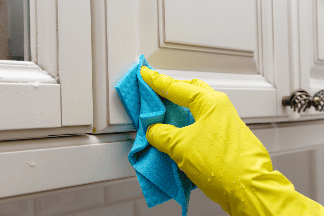The Art of Tenant Management in 3 Easy Steps
By Jason Kogok, Author of Plug the Holes Fill the Barrel
The best investors have one thing in common – excellent tenant management skills. If you’ve ever owned rental property, whether it be a single house or large apartment complex, you know firsthand that a good tenant is worth their weight in gold. Some of us also know that a bad tenant can make you reconsider even investing at all. Over decades of investing, I’ve learned a few tips that may help you in your journey.

- Being proactive instead of reactive when it comes to repairs,
- Doing an in-depth qualification process and
- Master tenant communication and create an environment for them to become attached to the home as if it was their own.
Those may sound like common sense things you may already know, but do you really?
Let’s look at the first trait – being proactive with repairs. I’ve been told before that I can be proactive to a fault and while that may be true some of the times, when it comes to the repair management on my properties, you can’t be too proactive. Here are a few tips that you should consider:
- General repairs. Have you ever had a running toilet that you pay a handyman to replace the parts inside the tank only to have those “universal” replacement parts not really be universal? How about dripping faucets and you try to save some money by replacing those tiny rubber washers only to have to end up replacing the faucet shortly after. The list goes on with similar maintenance items that landlords try to do patch repairs instead of just replacing. I have learned that the cost of two fixes and one replacement are often very similar costs and the replacement causes less headache for the tenant and you.
- Repairs between tenants. This is probably the most important item in this list. The majority of landlords I know simply wait until something breaks before getting it fixed. While on the surface that sounds correct, the reality is that if we do property inspections every so often or in between tenants, we can identify items that are on the verge of breaking – stuck windows, dripping faucets, sticking doors, running toilets, old appliances, rusting hot water heaters, etc. The list goes on. Instead of waiting for something to become an issue, I simply proactively repair or replace the item. This allows me to not inconvenience the tenant because I can do it in between the tenants. I can also get better pricing power on labor and materials when doing multiple repairs at a single time. Finally, it allows me to do the repairs on my time and terms. Many times, as a property owner, when repairs pop up, they are never at an ideal time in my life. Being proactive to protect your property is one of the most effective ways to be in control of your expenses instead of your expenses in control of you. It’s similar to how you would change the oil in your car or put new tires on before you have a blowout – don’t wait for a small issue to become something major
Here are a few maintenance tips as well to save money:
- HVAC servicing 1-2 times per year. This simple task allows you to stay ahead of large and unexpected expenses. One year, I replaced 2 HVAC’s during the week of July 4th. Do you think the HVAC tech labor was more expensive during that particular summer holiday week? Yup, sure was. Do you think I had limited options with which HVAC techs were working and which supply houses were open? Yup, sure did. I had to pay a substantial amount more simply due to the timing of the repair. I knew those HVAC systems were old and on their last leg, so none of it should have been a surprise. Had I been proactive instead of reactive, I could have shopped vendors and supply houses and done the repair on my terms.
- Gutters cleaning 1-2 times per year. Not only does it make the exterior of the home look more appealing, which appeases your neighbors and gives more pride to your tenants in the home they’re living in, it also affords you the opportunity to have someone on your roof who can also do a quick inspection for you. I can’t tell you the number of times my gutter cleaner has noticed a broken shingle or nail pop that I was able to have addressed before it became a real issue.
- Termite/pest inspection annually. Instead of paying for costly annual warranty and pest contracts, I simply have my properties inspected once a year. If there are pests, I get them treated. It’s an affordable, yet effective way to protect your asset.
Those are just a few examples of being proactive versus reactive that saves me time and money.
The next trait that you need to perfect is tenant qualification. I’m sure some of you are reading that and saying ‘well, that’s a pretty obvious item,’ but hang in with me on this. I have seen an array of “qualifications” over the years and honestly, few investors really do a thorough application process. Some will leave it to their property managers and never really ask any follow up questions. Some investors will do it themselves, but not really dive too deep into the applicant’s history for fear of being too intrusive or spook off a good prospect. If you were to lend a complete stranger hundreds of thousands of dollars, you would probably do a very in-depth qualification process to ensure you’d get that money back. If you agree with that, then why would handing over the keys to an asset worth hundreds of thousands of dollars be any different?
I always ensure I use the 7 C’s
- Checking their social media accounts
- Calling current employers
- Copy of bank statements
- Calling several past landlords
- Checking drivers license for address and expiration date
- Credit, background, eviction & income verification reports
- Complete a full application
As a wise investor once told me, it’s easier to trim the fat off of a steak before you cook it. Basically, it means do a really thorough (and possibly annoying) application process up front and you’ll end up with less headaches and lower vacancy in the long run, which gives better cash flow.
The last trait to master is probably the most underrated and underutilized, yet can be one of your most powerful management tools. You need to put the tenant first. All too often, landlords have a tendency to put themselves in a hierarchy type of position and the reality is that the tenant is your customer and without customers, you have no business. We’ve all been standing in line at a store where we’ve witnessed an issue between a customer and an employee and inevitably, when the employee handles the customer with courtesy, care and attempts to resolve the issue, the overall situation turns out better. However, we’ve also witnessed employees take a harsher tone and don’t try to effectively resolve the issue resulting in a less than ideal result. Managing your tenants is no different. As the landlord, we’re the employee and the tenant is our customer. While at the end of the day, the employee may be the ultimate decider on how the situation plays out, you have to put the customer first. How you handle those interactions are critical to the success of your tenant relationship, which will directly affect your vacancy and cash flow.
Here are a few things I do with my tenants to help create a friendly relationship:
- When my tenants move in, I leave a small handwritten note, along with a small gift card to a neighborhood restaurant as a welcome gesture
- If they have an approved pet, I’ll leave some pet treats
- I’ll send them a $5 coffee gift card on their birthdays
- I’ll offer them a gift card to Home Depot or Lowes annually if they want to do some extra flower planting or add something to the home they would enjoy
- I always remember their pet names and when I reach out to them, I always ask how their pet is doing by name
- I’ll do small upgrades to the home that they may enjoy – that could be as simple as some outdoor lights, or a WiFi thermostat or a small fire pit
Ask yourself – is a tenant more likely to destroy the house of a person they like or dislike? These very small and affordable things create a friendly environment and open up lines of communication. Since doing that, I have had so many tenants that stay longer because they feel at ‘home’ in the rental; they don’t feel like a guest. They are more likely to invite friends over and create friendships with neighbors. They even fix a lot of minor things in the home themselves because they don’t want to bother me. The return on my investment with positive communication and these small tokens of appreciation is through the roof.
I should also be very clear – you can be friendly, yet still very straightforward and firm with the business side of things. Some landlords feel that if you’re nice to a tenant then you can’t be firm if need be. I totally disagree with that notion.
Master these traits and watch your cash flow and rate of returns soar!
About the Author

















 Accessibility
Accessibility